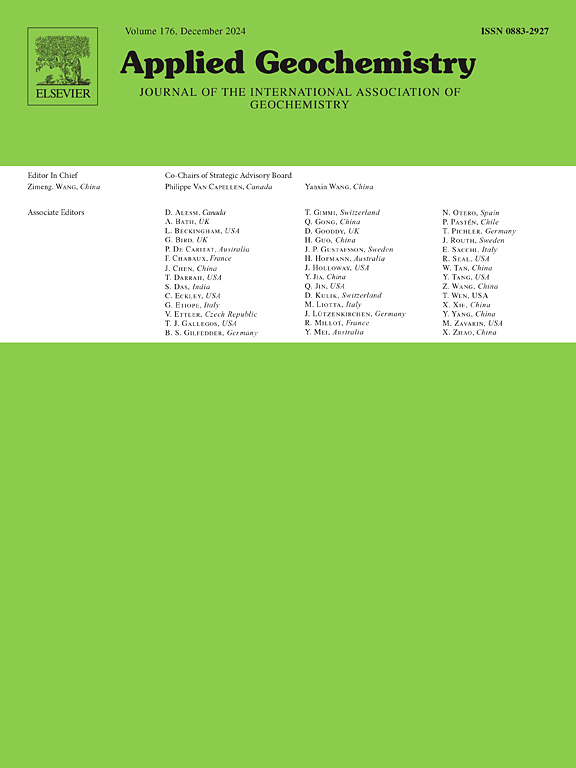在科西嘉岛进行环境取样以捕捉生物可利用的锶同位素分布
IF 3.4
3区 地球科学
Q1 GEOCHEMISTRY & GEOPHYSICS
引用次数: 0
摘要
锶同位素(87Sr/86Sr)是一种强大的地球化学示踪剂,可用于重建生物考古和古生态物质的流动性和物源。本研究提出了基于环境样本的科西嘉岛第一个生物可利用锶同位素景观,并将这些新结果与全球预测模型进行了比较。环境样本包括来自全岛125个采样点的植物(n = 245)和硝酸铵浸出土壤(n = 81)样本,为科西嘉岛建立了一个全面的生物可利用锶基线。87Sr/86Sr的空间变化趋势与地质年龄和岩性有关,总体变化范围为0.7075 ~ 0.7169。土壤渗滤液样品的87Sr/86Sr值明显低于对照植物样品。在岛屿周围700米的内陆范围内观察到海浪对陆地样品的影响。在地质单元内使用普通克里格法创建了一个等值图,以捕捉地质和环境条件对科西嘉岛上生物可利用的87Sr/86Sr的影响。与全球生物可利用锶等值线图相比,这里创建的基线显示出很大的差异,特别是在Variscan Corsica的较老岩性(石炭系花岗岩和二长花岗岩,以及二叠纪流纹岩)上收集的样本。虽然全球等景观预测了87Sr/86Sr值的整体空间格局,但仍然需要广泛的环境采样来捕捉更精细的87Sr/86Sr值变化,特别是在地质复杂的地区。科西嘉岛的生物可利用锶同位素基线可以解释岛上考古和古生态样品的流动性。本文章由计算机程序翻译,如有差异,请以英文原文为准。
Environmental sampling to capture bioavailable strontium isotope distributions on Corsica
Strontium isotopes (87Sr/86Sr) are a powerful geochemical tracer to reconstruct mobility and provenance of bioarcheological and palaeoecological materials. This study presents the first bioavailable Sr isoscape for Corsica based on environmental samples and compares these new results to a global predictive model. The environmental samples consist of plant (n = 245) and ammonium nitrate leached soil (n = 81) samples from 125 sampling sites across the island, creating a comprehensive bioavailable strontium baseline for Corsica. Observed spatial trends in 87Sr/86Sr are related to the geological age and lithology, with an overall range of 0.7075–0.7169. Soil leachate samples exhibit significantly lower 87Sr/86Sr values than their paired plant counterparts. The influence of sea spray on terrestrial samples is observed up to 700 m inland around the island. An isoscape was created using Ordinary Kriging within geological units to capture both the influence of geological and environmental conditions on the biologically available 87Sr/86Sr of Corsica. Compared to a global bioavailable strontium isoscape, the baseline created here shows large differences, especially for samples collected on older lithologies of Variscan Corsica (Carboniferous granite and monzogranite, and Permian rhyolitoid). While the global isoscape predicts the overall spatial patterning of 87Sr/86Sr values, there is a continued need for extensive environmental sampling to capture the finer scale 87Sr/86Sr values variability, especially in geologically complex areas. This bioavailable Sr isotope baseline for Corsica allows for the interpretation of mobility from archaeological and palaeoecological samples on the island.
求助全文
通过发布文献求助,成功后即可免费获取论文全文。
去求助
来源期刊

Applied Geochemistry
地学-地球化学与地球物理
CiteScore
6.10
自引率
8.80%
发文量
272
审稿时长
65 days
期刊介绍:
Applied Geochemistry is an international journal devoted to publication of original research papers, rapid research communications and selected review papers in geochemistry and urban geochemistry which have some practical application to an aspect of human endeavour, such as the preservation of the environment, health, waste disposal and the search for resources. Papers on applications of inorganic, organic and isotope geochemistry and geochemical processes are therefore welcome provided they meet the main criterion. Spatial and temporal monitoring case studies are only of interest to our international readership if they present new ideas of broad application.
Topics covered include: (1) Environmental geochemistry (including natural and anthropogenic aspects, and protection and remediation strategies); (2) Hydrogeochemistry (surface and groundwater); (3) Medical (urban) geochemistry; (4) The search for energy resources (in particular unconventional oil and gas or emerging metal resources); (5) Energy exploitation (in particular geothermal energy and CCS); (6) Upgrading of energy and mineral resources where there is a direct geochemical application; and (7) Waste disposal, including nuclear waste disposal.
 求助内容:
求助内容: 应助结果提醒方式:
应助结果提醒方式:


